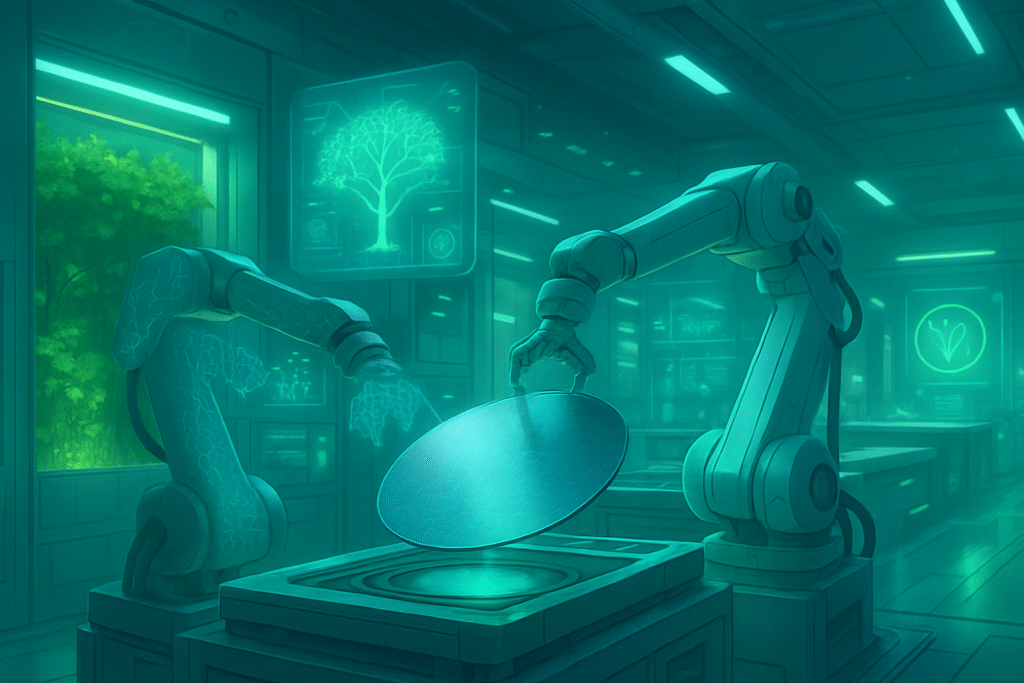
The global semiconductor industry, the foundational bedrock of all modern technology, is undergoing a profound transformation. Driven by escalating environmental concerns, stringent regulatory pressures, and the insatiable demand for energy-intensive AI hardware, manufacturers are accelerating their commitment to sustainability. This pivot towards eco-friendly practices is not merely a corporate social responsibility initiative but a strategic imperative, reshaping how the powerful chips that fuel our AI-driven future are designed, produced, and ultimately, recycled.
As of late 2025, this green revolution in silicon manufacturing is gaining significant momentum. With the AI boom pushing the limits of chip complexity and energy consumption, the industry faces the dual challenge of meeting unprecedented demand while drastically curtailing its environmental footprint. The immediate significance lies in mitigating the colossal energy and water usage, chemical waste, and carbon emissions associated with fabricating advanced AI processors, ensuring that the pursuit of artificial intelligence does not come at an unsustainable cost to the planet.
Engineering a Greener Chip: Technical Advancements and Eco-Friendly Fabrication
The semiconductor industry's sustainability drive is characterized by a multi-faceted approach, integrating advanced technical solutions and innovative practices across the entire manufacturing lifecycle. This shift represents a significant departure from historical practices where environmental impact, while acknowledged, often took a backseat to performance and cost.
Key technical advancements and eco-friendly practices include:
- Aggressive Emissions Reduction: Manufacturers are targeting Scope 1, 2, and increasingly, the challenging Scope 3 emissions. This involves transitioning to renewable energy sources for fabs, optimizing manufacturing processes to reduce greenhouse gas (GHG) emissions like perfluorocarbons (PFCs) – which have a global warming potential thousands of times higher than CO₂ – and engaging supply chains to foster sustainable practices. For instance, TSMC (TPE: 2330), a leading foundry, has committed to the Science Based Targets initiative (SBTi), aiming for net-zero by 2050, while Intel (NASDAQ: INTC) achieved 93% renewable energy use in its global operations as of 2023. The Semiconductor Climate Consortium (SCC), established in 2022, is playing a pivotal role in standardizing data collection and reporting for GHG emissions, particularly focusing on Scope 3 Category 1 (purchased goods and services) in its 2025 initiatives.
- Revolutionizing Resource Optimization: Chip fabrication is notoriously resource-intensive. A single large fab can consume as much electricity as a small city and millions of gallons of ultrapure water (UPW) daily. New approaches focus on energy-efficient production techniques, including advanced cooling systems and optimized wafer fabrication. TSMC's "EUV Dynamic Energy Saving Program," launched in September 2025, is projected to reduce peak power consumption of Extreme Ultraviolet (EUV) tools by 44%, saving 190 million kilowatt-hours of electricity and cutting 101 kilotons of carbon emissions by 2030. Water recycling and reclamation technologies are also seeing significant investment, with companies like TSMC achieving 12% water resource replacement with reclaimed water in 2023, a challenging feat given the stringent purity requirements.
- Embracing Circular Economy Principles: Beyond reducing consumption, the industry is exploring ways to minimize waste and maximize material utility. This involves optimizing manufacturing steps to reduce material waste, researching biodegradable and recyclable materials for components like printed circuit boards (PCBs) and integrated circuits (ICs), and adopting advanced materials such as Gallium Nitride (GaN) and Silicon Carbide (SiC) for power electronics, which offer superior energy efficiency.
- AI as a Sustainability Enabler: Crucially, AI itself is being leveraged to drive sustainability within manufacturing. AI-driven systems are optimizing design, production, and testing stages, leading to reduced energy and water consumption, enhanced efficiency, and predictive maintenance. Google (NASDAQ: GOOGL) has developed a "Compute Carbon Intensity (CCI)" metric to assess emissions per unit of computation for its AI chips, influencing design improvements for lower carbon emissions. This represents a significant shift from viewing AI hardware solely as an environmental burden to also recognizing AI as a powerful tool for environmental stewardship.
These initiatives represent a stark contrast to previous decades where environmental considerations were often secondary. The current approach is proactive, integrated, and driven by both necessity and opportunity. Initial reactions from the AI research community and industry experts are largely positive, viewing these efforts as essential for the long-term viability and ethical development of AI. There's a growing consensus that the "greenness" of AI hardware will become a key performance indicator alongside computational power, influencing procurement decisions and research directions.
Reshaping the AI Landscape: Competitive Implications and Market Dynamics
The semiconductor industry's aggressive pivot towards sustainability is not just an environmental mandate; it's a powerful force reshaping competitive dynamics, influencing market positioning, and potentially disrupting existing products and services across the entire tech ecosystem, especially for companies deeply invested in AI.
Companies that can demonstrably produce energy-efficient, sustainably manufactured chips stand to gain a significant competitive advantage. Major AI labs and tech giants, many of whom have their own ambitious net-zero targets, are increasingly scrutinizing the environmental footprint of their supply chains. This means that semiconductor manufacturers like TSMC (TPE: 2330), Intel (NASDAQ: INTC), Samsung (KRX: 005930), and NVIDIA (NASDAQ: NVDA) that can offer "green" silicon will secure lucrative contracts and strengthen partnerships with influential tech players like Google (NASDAQ: GOOGL), Microsoft (NASDAQ: MSFT), and Amazon (NASDAQ: AMZN) Web Services. This creates a new dimension of competition, where environmental performance becomes as critical as raw processing power.
Conversely, companies slow to adopt sustainable practices risk falling behind. They may face higher operational costs due to energy and water inefficiencies, struggle to meet regulatory requirements, and potentially lose market share as environmentally conscious customers and partners seek out greener alternatives. This could lead to a disruption of existing product lines, with older, less sustainable chip architectures gradually phased out in favor of newer, more eco-friendly designs. Startups focused on sustainable materials, energy-efficient chip designs, or AI-driven manufacturing optimization are also poised to benefit, attracting investment and becoming key partners for established players. Initiatives like "Startups for Sustainable Semiconductors (S3)" are fostering innovation in areas such as advanced cooling and AI-driven energy management, highlighting the emerging market for sustainable solutions.
Moreover, the drive for sustainability, coupled with geopolitical considerations, is encouraging localized production and enhancing supply chain resilience. Regions like the U.S. and Europe, through legislation such as the U.S. CHIPS and Science Act and Europe's Ecodesign for Sustainable Products Regulation (ESPR), are incentivizing domestic semiconductor manufacturing with a strong emphasis on sustainable practices. This could lead to a more diversified and environmentally responsible global supply chain, reducing reliance on single regions and promoting best practices worldwide. The market positioning of companies will increasingly depend not just on technological prowess but also on their verifiable commitment to environmental stewardship.
The Broader Canvas: AI, Environment, and Ethical Innovation
The semiconductor industry's green initiatives resonate far beyond the factory floor, fitting into a broader narrative of responsible technological advancement and the ethical deployment of AI. This shift acknowledges that the exponential growth of AI, while promising immense societal benefits, also carries significant environmental implications that must be proactively addressed.
This movement aligns with global trends towards sustainable development and corporate accountability. It underscores a growing awareness within the tech community that innovation cannot occur in an environmental vacuum. The massive energy consumption associated with training and operating large AI models, coupled with the resource-intensive manufacturing of AI hardware, has prompted critical discussions about the "carbon cost" of intelligence. These sustainability efforts represent a concrete step towards mitigating that cost, demonstrating that powerful AI can be developed and deployed more responsibly.
Potential concerns, however, still exist. The transition to greener production processes requires substantial initial capital investments, which can be an obstacle for smaller players or those in developing economies. There's also the challenge of "greenwashing," where companies might overstate their environmental efforts without genuine, measurable impact. This highlights the importance of standardized reporting, such as that championed by the SCC, and independent verification. Nevertheless, compared to previous AI milestones, where environmental impact was often an afterthought, the current emphasis on sustainability marks a significant maturation of the industry's approach to technological development. It signifies a move from simply building powerful machines to building powerful, responsible machines.
The broader significance also extends to the concept of "AI for Good." While AI hardware production is resource-intensive, AI itself is being leveraged as a powerful tool for sustainability. AI applications are being explored for optimizing power grids, managing energy consumption in data centers, identifying efficiencies in complex supply chains, and even designing more energy-efficient chips. This symbiotic relationship – where AI demands greener infrastructure, and in turn, helps create it – is a critical aspect of its evolving role in society. The industry is effectively laying the groundwork for a future where technological advancement and environmental stewardship are not mutually exclusive but deeply intertwined.
The Road Ahead: Future Developments and the Sustainable AI Frontier
The journey towards fully sustainable semiconductor manufacturing is ongoing, with significant developments expected in both the near and long term. Experts predict that the coming years will see an intensification of current trends and the emergence of novel solutions, further shaping the landscape of AI hardware and its environmental footprint.
In the near term, we can expect accelerated net-zero commitments from more semiconductor companies, potentially exceeding TechInsights' prediction of at least three top 25 companies by the end of 2025. This will be accompanied by enhanced transparency and standardization in GHG emissions reporting, particularly for Scope 3 emissions, driven by consortia like the SCC and evolving regulatory frameworks. Further refinements in energy-efficient production techniques, such as advanced cooling systems and AI-optimized wafer fabrication, will become standard practice. We will also see increased adoption of closed-loop water recycling technologies and a greater emphasis on reclaiming and reusing materials within the manufacturing process. The integration of AI and automation in manufacturing processes is set to become even more pervasive, with AI-driven systems continuously optimizing for reduced energy and water consumption.
Looking further ahead, the long-term developments will likely focus on breakthroughs in sustainable materials science. Research into biodegradable and recyclable substrates for chips, and the widespread adoption of next-generation power semiconductors like GaN and SiC, will move from niche applications to mainstream manufacturing. The concept of "design for sustainability" will become deeply embedded in the chip development process, influencing everything from architecture choices to packaging. Experts predict a future where the carbon footprint of a chip is a primary design constraint, leading to fundamentally more efficient and less resource-intensive AI hardware. Challenges that need to be addressed include the high initial capital investment required for new sustainable infrastructure, the complexity of managing global supply chain emissions, and the need for continuous innovation in material science and process engineering. The development of robust, scalable recycling infrastructure for advanced electronics will also be crucial to tackle the growing e-waste problem exacerbated by rapid AI hardware obsolescence.
Ultimately, experts predict that the sustainable AI frontier will be characterized by a holistic approach, where every stage of the AI hardware lifecycle, from raw material extraction to end-of-life recycling, is optimized for minimal environmental impact. The symbiotic relationship between AI and sustainability will deepen, with AI becoming an even more powerful tool for environmental management, climate modeling, and resource optimization across various industries. What to watch for in the coming weeks and months includes new corporate sustainability pledges, advancements in sustainable material research, and further legislative actions that incentivize green manufacturing practices globally.
A New Era for Silicon: Sustaining the Future of AI
The semiconductor industry's fervent embrace of sustainability marks a pivotal moment in the history of technology and AI. It signifies a collective acknowledgment that the relentless pursuit of computational power, while essential for advancing artificial intelligence, must be tempered with an equally rigorous commitment to environmental stewardship. This green revolution in silicon manufacturing is not just about reducing harm; it's about pioneering new ways to innovate responsibly, ensuring that the foundations of our AI-driven future are built on sustainable bedrock.
The key takeaways from this transformative period are clear: sustainability is no longer an optional add-on but a core strategic imperative, driving innovation, reshaping competitive landscapes, and fostering a more resilient global supply chain. The industry's proactive measures in emissions reduction, resource optimization, and the adoption of circular economy principles, often powered by AI itself, demonstrate a profound shift in mindset. This development's significance in AI history cannot be overstated; it sets a precedent for how future technological advancements will be measured not just by their capabilities but also by their environmental footprint.
As we look ahead, the long-term impact of these initiatives will be a more ethical, environmentally conscious, and ultimately more resilient AI ecosystem. The challenges, though significant, are being met with concerted effort and innovative solutions. The coming weeks and months will undoubtedly bring further announcements of breakthroughs in sustainable materials, more ambitious corporate pledges, and new regulatory frameworks designed to accelerate this green transition. The journey to fully sustainable semiconductor manufacturing is a complex one, but it is a journey that the industry is unequivocally committed to, promising a future where cutting-edge AI and a healthy planet can coexist.
This content is intended for informational purposes only and represents analysis of current AI developments.
TokenRing AI delivers enterprise-grade solutions for multi-agent AI workflow orchestration, AI-powered development tools, and seamless remote collaboration platforms.
For more information, visit https://www.tokenring.ai/.






